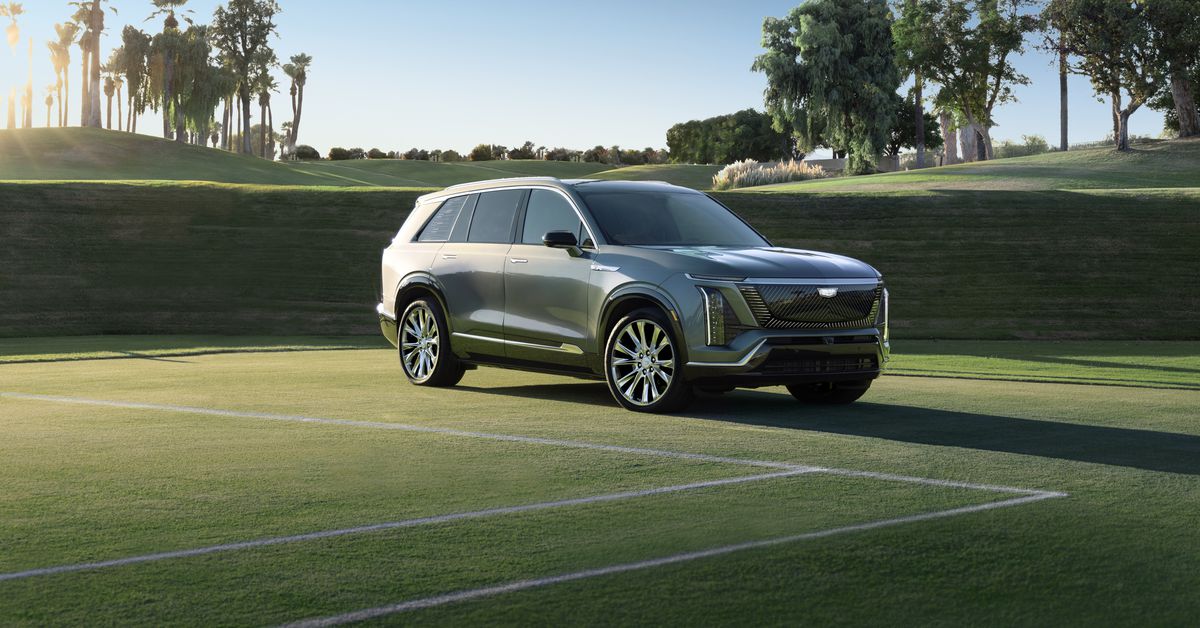Buoyed by a bustling EV business, GM is ready to take the wraps off its next offering. On Tuesday, Cadillac officially announced the 2026 Vistiq SUV, a three-row SUV with 300 miles of range and a starting price of $80,185.
The Vistiq joins the Lyriq, Optiq, and Escalade IQ, as well as the ultra-luxury, bespoke Celestiq, in Cadillac’s growing family of electric vehicles. And it comes as GM’s EV sales have surged thanks to an improved production cadence and a more diverse lineup than many of its rivals.
Cadillac’s growing family of electric vehicles
The Vistiq will slot in at the high end of GM’s plug-in vehicles, with a starting price of $78,790 plus a $1,395 destination charge. The electric SUV will be built starting early next year at GM’s Spring Hill, Tennessee, plant, where the smaller Lyriq is already produced, which means it could qualify for federal tax credits, as long as those credits are still around.
The Vistiq is also carrying over a lot of the design touches first found in the Lyriq, like flush door handles and a diamond-cut pattern on the faux grille. The side panels are indented like the Lyriq, and the front and rear lights are almost identical as well.
The swept-back windshield is more akin to the Escalade IQ, which will sit alongside the Vistiq when it goes into production next year. But while that EV is being positioned as the ultimate in plug-in luxury, the Vistiq is for buyers okay with settling for something slightly less expensive.
That means a little less power than the Escalade IQ but still plenty of acceleration and range. The dual-motor Vistiq runs on a 102kWh battery (versus the 200kWh one powering the Escalade IQ), with 615 horsepower and 650 pound-feet of torque. Active rear steering will help with sharp turns and more maneuverability. And optional 23-inch wheels will provide improved visibility — but the height of your EV could make it more dangerous to pedestrians and vulnerable road users, so proceed with caution.
The Vistiq’s infotainment system will be powered by Android using Google’s built-in software service. That means navigation powered by Google Maps, available apps for download through the Google Play Store, and no support for popular phone projection features like Apple CarPlay and Android Auto. (GM’s software chief went on Decoder recently to defend the decision, despite most customers and analysts concluding it was a bad one.)
The dual-motor Vistiq runs on a 102kWh battery
A new feature for Cadillac will be the inclusion of bidirectional charging, which, with the right equipment, will enable vehicle-to-home (V2H) charging. GM’s home energy division recently started selling a V2H bundle that includes a home charger and an enablement kit for around $7,300. With this setup, Vistiq owners can run their home’s electricity off their EV battery during a blackout. In terms of regular charging, GM has yet to finalize its testing, so details such as fast-charging rates and 10–80 percent charge time are still up in the air.
The Vistiq will come with a number of other high-tech features, including improved safety warnings, OnStar collision assistance, and infrared-powered night vision, which displays on the instrument cluster for enhanced visibility on dark highways.
At launch, Cadillac will offer three distinct trims: Luxury, Sport and Premium Luxury. In 2025, the automaker will offer a Platinum trim, with “added performance elements and more interior and exterior color options, allowing the customer to choose a vehicle that matches their own personality and preferences.”
Cadillac is hoping to match the Lyriq’s success with this new three-row model. The Lyriq is one of the bestselling compact luxury EVs in the US right now and is responsible for a large portion of last year’s Cadillac sales increases.
But it will also go into production during a much less favorable environment for EVs, with a second presidential term for Donald Trump. The president-elect has vowed to eliminate the Biden administration’s EV incentives, including a federal tax credit of $7,500. GM’s aspirations for a “zero-emission” future and profitable EV business in the near term are highly reliant on federal tax credits.
Read the full article here














